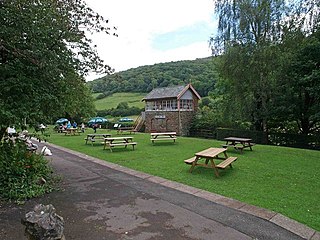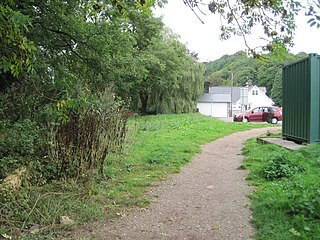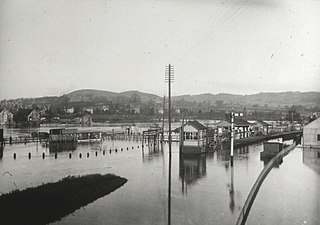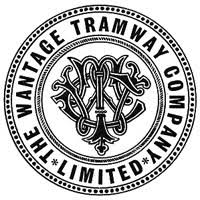
Tidenham is a village and civil parish in the Forest of Dean of west Gloucestershire, England, adjoining the Welsh border. Tidenham is bounded by the River Wye to the west and the River Severn to the south. Offa's Dyke runs through the western part of the parish, terminating at Sedbury cliff above the River Severn.
There are 22 disused railway stations in the 75 miles (121 km) between Bristol Temple Meads and Exeter St Davids, 12 of which have structures that can still be seen from passing trains. Most were closed in the 1960s but four of them, especially around Weston-super-Mare, were replaced by stations on new sites. 13 stations remain open on the line today, but there have been proposals to reopen stations at Cullompton and Wellington.

The Wye Valley Railway was a standard gauge railway that ran for nearly 15 miles (24 km) along the Lower Wye Valley between the towns of Chepstow and Monmouth, crossing several times between Wales and England. Opened on 1 November 1876, it was leased to, and worked by, the Great Western Railway (GWR), before being fully absorbed by the GWR in 1905.

Berkeley railway station served the town of Berkeley in Gloucestershire, England. The station was on the Sharpness Branch Line, part of the Midland Railway (MR), which connected the Bristol and Gloucester Railway main line at Berkeley Road station with the docks at Sharpness.

Monmouth Troy was one of the two former railway stations at Monmouth. It was built in 1857 by the Coleford, Monmouth, Usk and Pontypool Railway and was used by several other branch lines as the local rail network expanded. The station closed in January 1964 following the closure of the last two lines to the station, the Wye Valley Railway and the Ross and Monmouth Railway.

Tintern railway station served the village of Tintern on the Wye Valley Railway. It was opened in 1876 and closed for passengers in 1959 and freight in 1964, when the line was closed completely. It was the second largest station on the line, the most substantial being Monmouth Troy railway station.
Brockweir Halt was a request stop on the former Wye Valley Railway. It was opened to the public on 19 August 1929. It closed in 1959 when passenger services were withdrawn from the line. It was situated just north of Brockweir bridge. Nothing now remains of the trackbed because of the realignment of the A466.
Llandogo Halt was a request stop on the former Wye Valley Railway. It was opened on 9 March 1927 to serve the village of Llandogo. It was closed in 1959 following the withdrawal of passenger services on the line. It was the smallest construction on the Wye Valley Railway.

The Coleford, Monmouth, Usk & Pontypool Railway (CMU&PR) was a standard gauge railway of 16 miles (26 km) which ran from Monmouth to Little Mill, near Pontypool in Monmouthshire, Wales. It was intended to convey the mineral products of the Forest of Dean to the ironworks of South Wales, by connecting to the Newport, Abergavenny and Hereford Railway at Little Mill Junction. The NAHR made the onward connection over its Taff Vale Extension line. The CMU&PR intended to acquire the Monmouth Railway, actually a horse-operated plateway, and convert it to locomotive operation.

St Briavels Station was a station along the Wye Valley Railway. It was built in 1876 during the construction of the line on the Monmouthshire side of the River Wye at Bigsweir, and was intended to serve the nearby villages of St Briavels, across the river in the Forest of Dean, and Llandogo, which is further down the Wye Valley. It was closed on 5 January 1959 when the line was closed to passenger services.
Whitebrook Halt was a request stop on the former Wye Valley Railway. It was opened in 1927 to serve the village of Whitebrook. It was closed in 1959 when passenger services were withdrawn from the Wye Valley Railway. The station came too late to make full use out of the village's industry. Whitebrook had once been home to three paper mills. However, paper making ceased in Whitebrook in the early 1880s, only four years after the line opened in 1876. The halt was not built until long after the closure of the paper mills.

Penallt Halt was a request stop on the former Wye Valley Railway. It was opened on 1 August 1931 and closed in 1959. Penallt Halt and Redbrook Station were the closest stations on the line with only Penallt Viaduct separating them. Penallt Halt was close to the village of Redbrook.

The Ross and Monmouth Railway was a standard gauge railway of 13 miles (21 km) which ran between Ross-on-Wye, in Herefordshire, England and Monmouth, Wales.

Redbrook on Wye railway station was a station serving the village of Redbrook on the now disused Wye Valley Railway. It was opened on 1 November 1876 with the rest of the line and remained open for 83 years, it closed in 1959. The sidings and passing loop remained open until late 1961 to serve the Tinplate Works in the village.

Penallt Viaduct is a viaduct that formerly carried the Wye Valley Railway over the River Wye, which at this location forms the border between England (Gloucestershire) and Wales (Monmouthshire). The 14-mile (23 km) Wye Valley Railway opened on 1 November 1876.

Monmouth Mayhill railway station is a disused railway station on the Ross and Monmouth Railway which was opened in 1873 and closed in 1959. It was one of two stations that served the town of Monmouth, Wales and was situated on the opposite bank of the river River Wye from Monmouth. It was the initial terminus of the line, but the line was extended across the River Wye to the junction station of Monmouth Troy in 1874 with the construction of the Duke of Beaufort Bridge.
Lydbrook Junction railway station is a disused railway station in England opened by the Ross and Monmouth Railway in 1873, it remained open for 91 years until 1964 when the line finally closed to freight, though passenger services ceased in 1959. The station was constructed in the hamlet of Stowfield approximately half a mile from Lydbrook and its viaduct on the Severn and Wye Railway. It was located approximately 4 miles and 34 chains along the railway from Ross-on-Wye station. In 1874 the Severn and Wye Railway opened a branch from Serridge Junction and Cinderford, passenger services commenced in 1875. All passenger trains along the S&W branch were withdrawn from 1929.

The Wantage Tramway Company was a two-mile tramway that carried passengers and freight between the Oxfordshire town of Wantage and Wantage Road Station on the Great Western Main Line in England. Formed in 1873 to link Wantage Road station with its terminus at Mill Street, Wantage the line was cheaply built parallel to what was then the Besselsleigh Turnpike, and now the A338. The tramway closed to passengers in 1925 and to goods traffic in 1945.
Chepstow East railway station was a temporary station on the South Wales Railway. It was on the opposite bank of the River Wye from Chepstow and was only used for a few months until the river was crossed by a railway bridge. This was about a mile from Chepstow railway station, at the road bridge close to the future junction of the Wye Valley line. It was opened on 19 September 1851 and served as a temporary station while the Chepstow railway bridge was being constructed across the river to link up with the rest of the line. It closed on 19 July 1852, the day that the bridge over the Wye was opened.
Tutshill for Beachley Halt was a request stop on the South Wales Railway and Wye Valley Railway. It was opened on 9 July 1934, and was intended to serve the nearby village of Tutshill. However, though the station was situated a short distance from the junction of the Wye Valley Railway and was still on the main line, the only trains which served the small halt were from the Wye Valley Railway and when the line closed on 5 January 1959, the stop closed with it.











